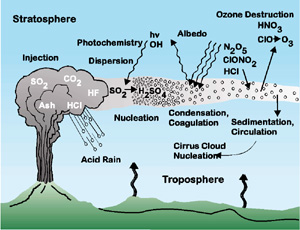EXPLORE: Plate Movement & Earth's Spheres (BrainPop)
Completion requirements
.
2. READ: Volcanoes & Earth's Spheres

Ways in which a volcano can affect Earth's atmosphere.
Courtesy of Wikimedia.
Volcanic eruptions can have a tremendous effect on Earth's atmosphere, affecting both short term and long term climate patterns, influencing the atmosphere and hydrosphere and affecting the biosphere.
The principle gases that are emitted during a volcanic eruption include: water vapor, carbon dioxide, carbon monoxide, sulfur dioxide, hydrogen sulfide, hydrogen chloride, and hydrogen fluoride. A large number of minor and trace gasses are also found in volcanic emissions, for example: hydrogen, carbon monoxide, nitrogen oxides, and volatile metal chlorides. Volcanic gases are harmful to most types of vegetation and can cause damage to the respiratory system of animals. For example, exposure to carbon monoxide can result in suffocation or death, depending on the length of exposure.
Of these gases, carbon dioxide and water vapor are greenhouse gases, and can contribute to global warming by trapping longwave radiation (infrared radiation, or heat) at the Earth's surface and lower atmosphere. Sulfur and nitrogen oxides can mix with the water vapor in the atmosphere and produce acid rain (which harms plants and water ecosystems). Some of these gases also contribute to the destruction of our ozone layer and cause tropospheric pollution (pollution in the lowest level of the atmosphere, which includes the air you breathe). Gases, dust, and ash from a volcanic eruption can also contribute to global cooling. If the eruption cloud is big enough to reach the stratosphere, it can produce a widespread cooling effect. Additionally, sulfate particles in the atmosphere reflect radiation from the sun, therefore preventing it from reaching Earth's surface. The exact climate impacts produced by a volcano is dependent upon how large the the eruption is, and what the global wind patterns are like.
Additionally, the dust and ash from a volcanic eruption can cause condensation nuclei to build in the atmosphere. Condensation nuclei are pieces of dust or ash around which water droplets collect. This forms clouds and can produce precipitation. Heavy rains triggered in this way can cause lahars (mud flows) and debris avalanches, which affect people and ecosystems living in the vicinity of a volcano. The largest impacts to the climate, biosphere, and hydrosphere are felt closest to the volcano.
Source: http://pubs.usgs.gov/of/1997/of97-262/of97-262.html